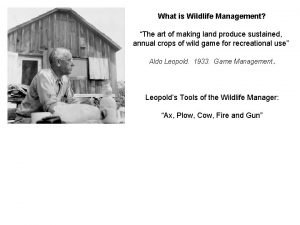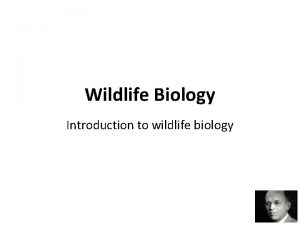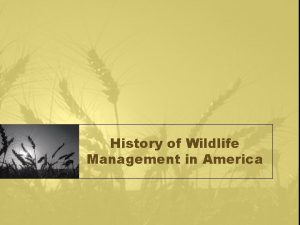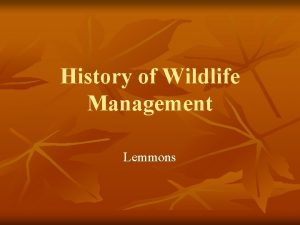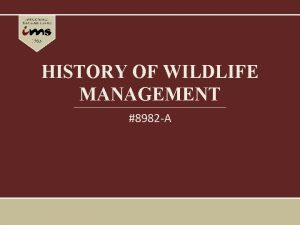What is Wildlife Management The art of making






- Slides: 6

What is Wildlife Management? “The art of making land produce sustained, annual crops of wild game for recreational use” Aldo Leopold. 1933. Game Management. Leopold’s Tools of the Wildlife Manager: “Ax, Plow, Cow, Fire and Gun”

“The science and art of making decisions and taking action to manipulate the structure, dynamics and relations of populations, habitats and people to achieve specific human objectives by means of the wildlife resource” “Practically speaking, the wildlife manager works for particular wildlife users… the rightness of managerial decisions can only be judged relative to the employers objectives” R. H. Giles, Jr. 1978. Wildlife Management. W. H. Freeman, San Francisco. 416 pp.

“Wildlife management is the application of ecological knowledge to populations of vertebrate animals and their plant and animal associates in a manner that strikes a balance between the needs of those populations and the needs of people. ” Bolen and Robinson.

Diagram:

3 of Leopold’s 5 theorems: 1. The recreational value of a head of game is inverse to the artificiality of its origin 2. A proper game policy seeks a happy medium between the intensity of management necessary and that which would deteriorate its quality or recreational value. 3. The denser the human population the more intense the system of game management needed to supply the same proportion of people with hunting.

Social significance of game management Leopold, Game Management, 1933 p 420: “The game manager manipulates animals and vegetation to produce a game crop. This, however, is only a superficial indication of his social significance. What he really labors for is to bring about a new attitude toward the land. ” “In short, 20 centuries of ‘progress’ have brought the average citizen a vote, a national anthem, a Ford, a bank account and a high opinion of himself, but not the capacity to live in high density without befouling and denuding his environment, nor a conviction that such capacity, rather than such density, is the true test of whether he is civilized. The practice of game management may be one of the means of developing a culture which will meet that test. ”
